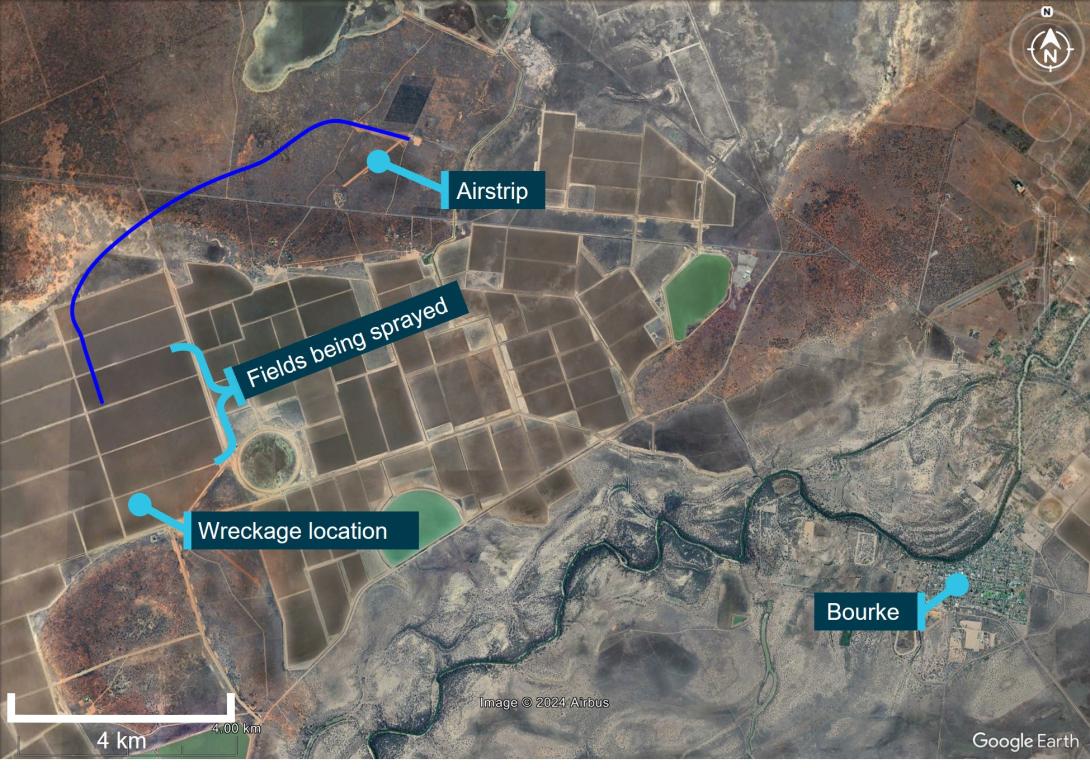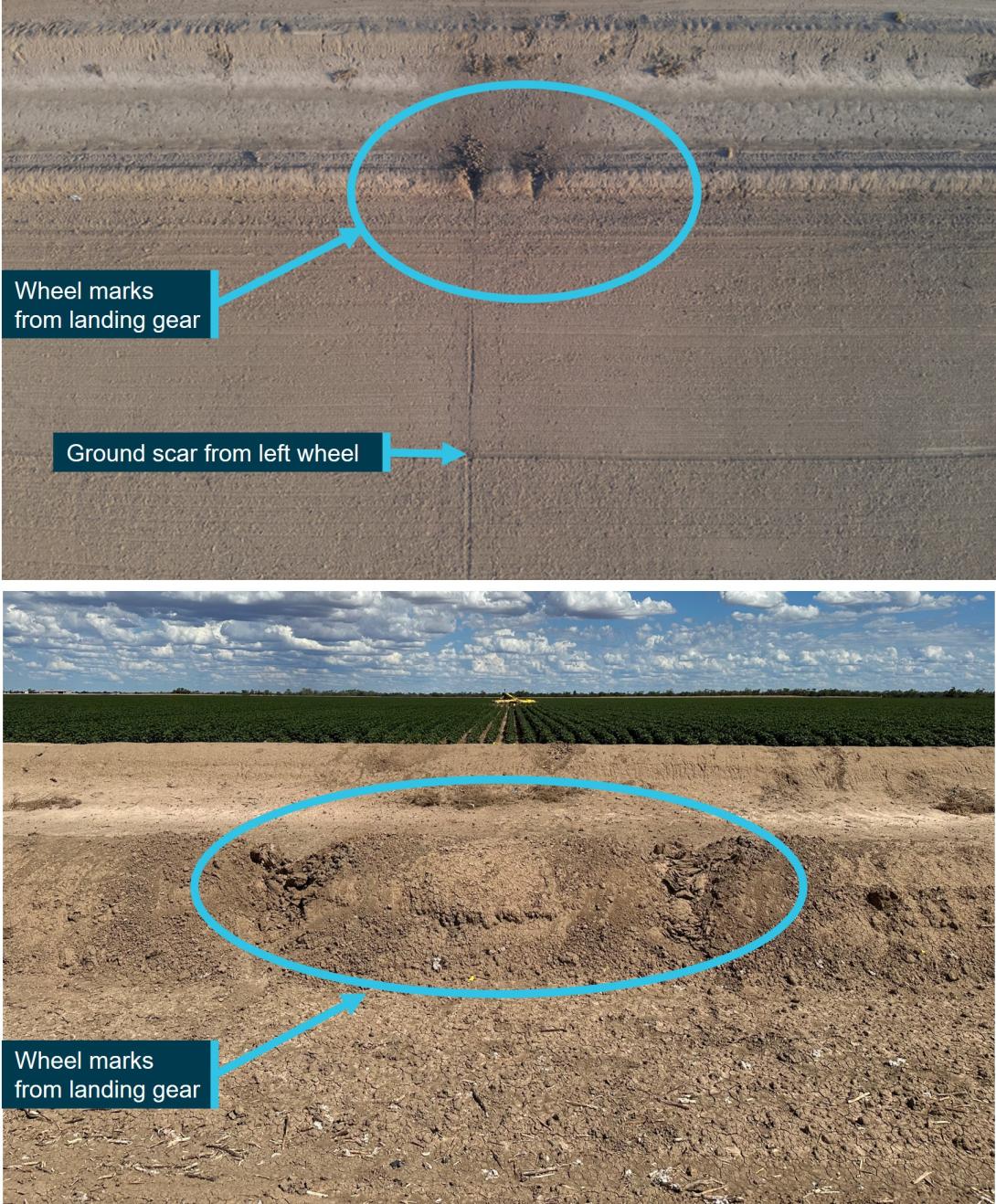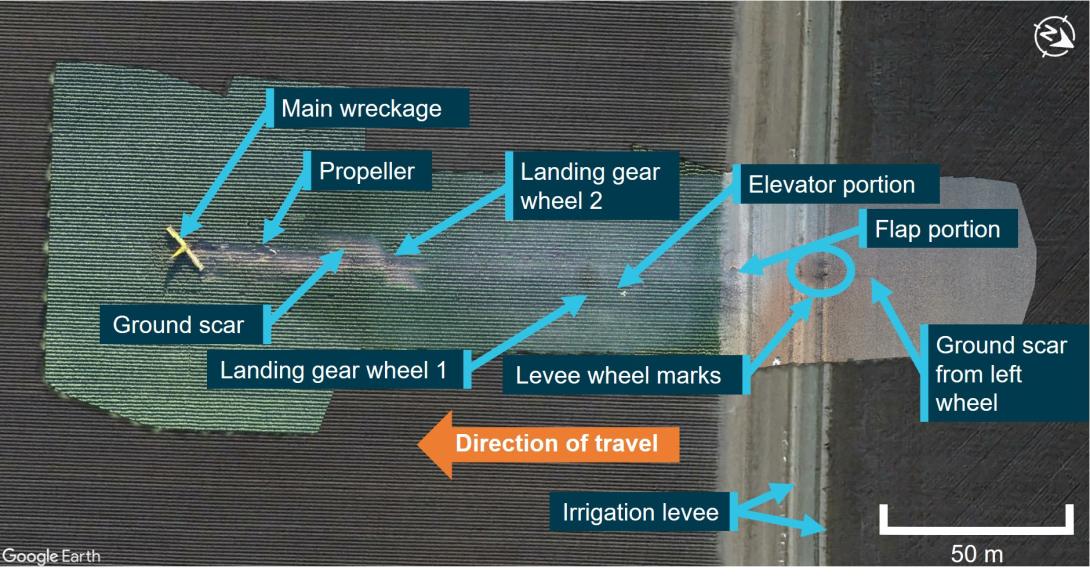Preliminary report released 17 July 2024
This preliminary report details factual information established in the investigation’s early evidence collection phase, and has been prepared to provide timely information to the industry and public. Preliminary reports contain no analysis or findings, which will be detailed in the investigation’s final report. The information contained in this preliminary report is released in accordance with section 25 of the Transport Safety Investigation Act 2003.
The occurrence
On the morning of 10 February 2024, the pilot of an Air Tractor AT‑502 aircraft, registered VH‑AQW (AQW) and operated by Rebel Ag, was conducting aerial spraying operations on a property near Bourke, New South Wales. The plan was to continue spraying herbicide on fields they had commenced the previous day.
At 0629 local time, AQW departed a private airstrip on the property in a southerly direction with the first load of herbicide (Figure 1). Another pilot also departed around this time to conduct spraying in a different area of the same property. At 0632, recorded data showed that AQW had commenced spraying a field. The recording ended 12 seconds later. The final point recorded AQW’s ground speed of about 114 kt and travelling in a south-easterly direction.
At about 0715, the other pilot attempted to contact the pilot of AQW on the ultra-high frequency radio, followed by a text message at about 0719, but received no response. The other pilot became concerned so decided to fly around the property to locate AQW. The aircraft wreckage was found in a cotton field adjacent to the field being sprayed. The pilot was fatally injured, and the aircraft was destroyed.
Figure 1: Overview of flight path (track in blue)
Source: Google Earth, annotated by the ATSB
Context
Pilot information
The pilot held a Commercial Pilot’s Licence (Aeroplane) and a valid Class 1 Aviation Medical Certificate. The pilot also held an aerial application rating, as well as float plane, manual propeller pitch control, tailwheel undercarriage, and gas turbine endorsements.
The pilot had 13,135.6 hours of total aeronautical experience, and at least 3,721.2 hours on Air Tractor aircraft variants based on information provided by the operator.
Aircraft information
VH-AQW was an Air Tractor Incorporated AT-502 single-seat low-wing tailwheel aircraft manufactured in the United States in 1993. It was powered by a Pratt & Whitney Canada PT6A‑34AG turboprop engine. It was first registered in Australia on 29 November 1993.
The current maintenance release was issued on 30 January 2024, with 18,162.5 hours recorded as the total time-in-service.
Meteorological information
Around the time of the accident, a private weather station located on the property recorded the air temperature as 26 °C and an average windspeed of about 9 kt from the south-south-east. At 0630, the Bourke Airport METAR[1] recorded the windspeed as 6 kt from the south-south-east.
Geoscience Australia recorded first light at 0627 and sunrise at 0652 at the accident site.
Wreckage and impact information
The ATSB’s site examination found that the aircraft had impacted an irrigation levee adjacent to the southernmost field to be sprayed. A ground scar about 27 m long from the aircraft’s left main wheel was found in the paddock just before the levee. Two more wheel marks were found where the main landing gear struck the levee (Figure 2).
Figure 2: Wheel marks in the paddock and levee
Source: New South Wales Police Force (top) and ATSB (below), annotated by the ATSB
A larger ground scar was found in an adjacent cotton field where additional debris, including the elevator, flap, and parts of the landing gear and the main wreckage was found. The propeller and parts of the engine were found in the large ground scar, indicating the aircraft collided with terrain nose down initially, then came to rest inverted (Figure 3). The ground scars and main wreckage were aligned with the final data point recorded on a track of about 150° magnetic and perpendicular to the levee at the site of the main wheel impact.
Figure 3: Overview of the wreckage distribution
Source: Google Earth and New South Wales Police Force, annotated by the ATSB
All the aircraft’s major components were present at the accident site with no evidence of an in‑flight break-up. There were no pre-impact defects identified that affected the airframe or flight controls. Examination of the propeller and engine indicated that the engine was delivering power at the time of the impact. Fuel and chemical product residues were also found at the accident site, but there was no post-impact fire.
The airframe around the cockpit had retained its structure, but the windscreen had fragmented resulting in the cockpit filling with mud.
The first responder reported that the pilot had been fastened into the seat by the aircraft’s 4-point harness and was wearing a flight helmet. The helmet was found intact but covered with the dried mud.
Operational information
The fields planned to be sprayed did not have crops and were being sprayed with herbicide chemicals in preparation for crop growth in a subsequent season. The surrounding terrain in the area was flat and the operator reported that they expected the accident run field to be sprayed at a height between 2–3 m above the ground, measured from the wheelbase of the aircraft.
Further investigation
The investigation is continuing and will include further review and examination of:
- electronic components recovered from the aircraft
- medical and pathological records
- operational documentation
- aircraft maintenance records.
A final report will be released at the conclusion of the investigation. Should a critical safety issue be identified during the course of the investigation, the ATSB will immediately notify relevant parties so appropriate and timely safety action can be taken.
Acknowledgements
The ATSB acknowledges the support of the staff from Darling Farms and the New South Wales Police Force for their assistance during the onsite investigation.
Purpose of safety investigations
The objective of a safety investigation is to enhance transport safety. This is done through:
- identifying safety issues and facilitating safety action to address those issues
- providing information about occurrences and their associated safety factors to facilitate learning within the transport industry.
It is not a function of the ATSB to apportion blame or provide a means for determining liability. At the same time, an investigation report must include factual material of sufficient weight to support the analysis and findings. At all times the ATSB endeavours to balance the use of material that could imply adverse comment with the need to properly explain what happened, and why, in a fair and unbiased manner. The ATSB does not investigate for the purpose of taking administrative, regulatory or criminal action.
Terminology
An explanation of terminology used in ATSB investigation reports is available here. This includes terms such as occurrence, contributing factor, other factor that increased risk, and safety issue.
Publishing information
Released in accordance with section 25 of the Transport Safety Investigation Act 2003
Published by: Australian Transport Safety Bureau
© Commonwealth of Australia 2024

Ownership of intellectual property rights in this publication
Unless otherwise noted, copyright (and any other intellectual property rights, if any) in this report publication is owned by the Commonwealth of Australia.
Creative Commons licence
With the exception of the Coat of Arms, ATSB logo, and photos and graphics in which a third party holds copyright, this publication is licensed under a Creative Commons Attribution 3.0 Australia licence.
Creative Commons Attribution 3.0 Australia Licence is a standard form licence agreement that allows you to copy, distribute, transmit and adapt this publication provided that you attribute the work.
The ATSB’s preference is that you attribute this publication (and any material sourced from it) using the following wording: Source: Australian Transport Safety Bureau
Copyright in material obtained from other agencies, private individuals or organisations, belongs to those agencies, individuals or organisations. Where you wish to use their material, you will need to contact them directly.
|
[1] METAR: a routine report of meteorological conditions at an aerodrome. METAR are normally issued on the hour and half hour.





